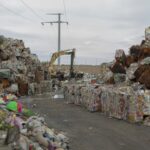Why Water Cycle Improvement in Nevada: Cities like Las Vegas and surrounding agricultural areas are significantly affected.?
Water Cycle Improvement, Climate Change Impacts, and more…
Great Basin Faces Water Crisis Amid Climate Change and Growing Demands
The Great Basin, a vast region encompassing parts of Nevada, Utah, California, Oregon, and Idaho, is grappling with a severe water crisis fueled by a combination of factors, including climate change, population growth, and intensive water use in agriculture and urban areas. The region’s arid environment, characterized by mountains and deserts, limits the amount of water that runs off and seeps into the ground, making water resources particularly vulnerable.
Las Vegas, a city synonymous with opulent hotels and extravagant water features, is heavily dependent on Lake Mead, a massive reservoir that has been shrinking due to drought and overuse. This shrinking reservoir highlights the urgent need for solutions to the region’s water shortage.
The Active Climate Rescue Initiative, a non-profit organization, is working tirelessly to address the water crisis in the Great Basin. Their efforts are a beacon of hope, offering potential solutions to this pressing challenge facing a vital part of the western United States.
💧 The Great Basin: A Land of Thirst and Innovation
TL;DR – Too Long; Didn’t Read
The Great Basin is a dry region facing water shortages due to a changing climate. Water is scarce, and places like Las Vegas and farmlands are struggling. Climate change is making things worse, but we can use innovative solutions like better irrigation and saving water to help. Organizations like the Active Climate Rescue Initiative are working hard to solve this problem.
The Water’s Journey: A Cycle in the Desert
Imagine a giant bathtub that’s mostly empty. That’s the Great Basin. It’s a vast area of the western United States, including parts of Nevada, Utah, California, and Oregon. It’s a land of deserts, mountains, and dry valleys. But even in the desert, there’s a water cycle, like a game of water tag!
Here’s how it works:
- Evaporation: The sun heats up water in lakes, rivers, and soil, turning it into vapor (like steam).
- Condensation: This water vapor rises into the air and cools down, turning back into tiny water droplets that form clouds.
- Precipitation: The water droplets in the clouds get heavy and fall back to Earth as rain or snow.
- Runoff: Rain and melted snow flow over the land, forming rivers and streams.
- Infiltration: Some water soaks into the ground, becoming groundwater, which can be used by plants and animals.
But in the Great Basin, the game of water tag isn’t always fair. The region is dry, and the mountains and deserts limit how much water runs off and soaks into the ground.
The Water Crisis: Running Dry
The Great Basin has always been a place where water is precious. But today, the situation is getting worse.
- Climate Change: As the Earth gets warmer, things like evaporation happen faster. This means that more water evaporates from lakes and rivers, making them shrink.
- Population Growth: More people live in the Great Basin now than ever before. This puts a strain on the already limited water supply.
- Agriculture: Farming uses a lot of water, and crops need plenty to grow.
- Urbanization: Cities like Las Vegas, with its casinos and resorts, need a lot of water for its residents and tourists.
This combination of factors is leading to water shortages.
The Impact on Nevada
Nevada is in the heart of the Great Basin. Cities like Las Vegas are struggling to keep up with the growing demand for water.
- Las Vegas: The city is known for its lavish hotels and water features, but it relies heavily on Lake Mead, a huge reservoir that has been shrinking due to drought and overuse.
- Agriculture: Farmers in Nevada rely on irrigation to grow crops in the dry climate. The shrinking water supply means farmers are facing tough choices about what crops to grow and how much water to use.
Finding Solutions: A Path to a Sustainable Future
The good news is that we can make a difference. There are solutions to help us manage the Great Basin’s water supply:
- Water Conservation: Saving water is key! We can use water-efficient appliances, fix leaks, and water our lawns less often.
- Innovative Irrigation Techniques: Farmers can use new irrigation methods that use less water, like drip irrigation, which delivers water directly to plant roots.
- Policy Measures: Governments can implement policies that encourage water conservation and protect water resources.
The Active Climate Rescue Initiative: A Beacon of Hope
The Active Climate Rescue Initiative is a non-profit organization working to address water shortages in the Great Basin. They are developing innovative solutions, like desalination plants that turn saltwater into freshwater, and water conservation programs.
Summary
The Great Basin is facing a water crisis due to a combination of factors including climate change, population growth, and intensive water use in agriculture and urban areas. Nevada, especially Las Vegas and its surrounding agricultural areas, are significantly affected. However, there is hope. Water conservation practices, innovative irrigation techniques, and policy measures offer potential solutions. Organizations like the Active Climate Rescue Initiative are working hard to develop new technologies and implement programs to alleviate the water shortage crisis. We can all do our part to conserve water and support initiatives that help secure the future of this precious resource.
More on Water Cycle Improvement…
- ## SEO Keywords for Water Cycle Improvement and Climate Change Impacts:
- General:
- Water cycle management
- Climate change adaptation
- Sustainable water management
- Water conservation
- Drought mitigation
- Flood prevention
- Climate resilience
- Water security
- Climate action
- Water resources management
- Specific to Water Cycle Improvement:
- Water harvesting
- Rainwater collection
- Groundwater recharge
- Water treatment
- Wastewater recycling
- Water infrastructure
- Water efficiency
- Water footprint
- Water pollution control
- Water quality improvement
- Specific to Climate Change Impacts:
- Climate change impacts on water resources
- Sea level rise
- Ocean acidification
- Extreme weather events
- Drought and desertification
- Flooding and waterlogging
- Climate change adaptation strategies
- Climate change mitigation
- Climate change vulnerability
- Climate change risk assessment
- Specific to Geographic Locations:
- Water cycle improvement in [specific region/country]
- Climate change impacts on [specific region/country]
- [Specific city] water management
- [Specific river basin] water resources
- Specific to Sectors:
- Water cycle improvement in agriculture
- Climate change impacts on urban development
- Water management for industries
- Climate change adaptation for tourism
- Specific to Solutions:
- Green infrastructure
- Water-sensitive urban design
- Climate-smart agriculture
- Sustainable water technologies
- Nature-based solutions for climate change
- Target Audience:
- Water professionals
- Environmentalists
- Policymakers
- Researchers
- Educators
- General public
- Other:
- Water cycle improvement news
- Climate change impacts research
- Water cycle improvement projects
- Climate change adaptation case studies
- Water cycle improvement funding
- Climate change impacts data




